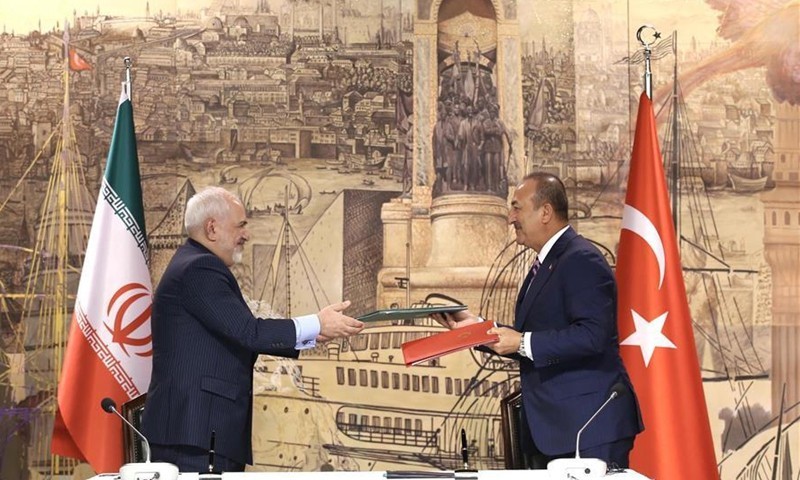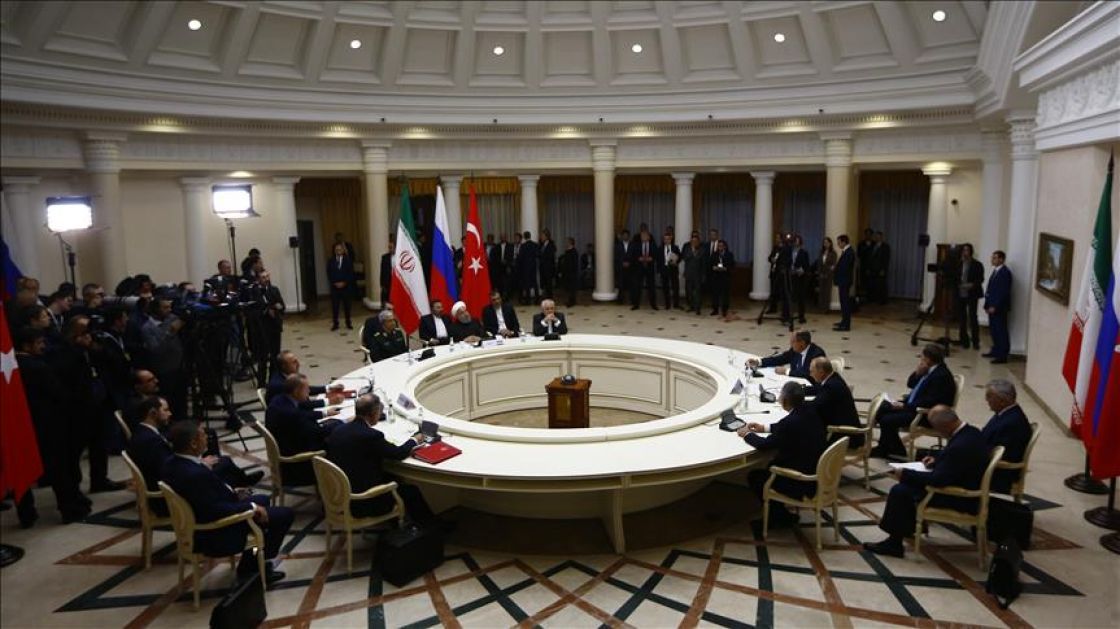- Articles
- Posted
Working Against “Astana” As One of the Tools of “Normalization”!
American policy has a set of general trends that remain the same across the various administrations. The policy has a strategic aspect that is directly related to the nature of the American understanding and definition of “American national security”. Among these unchanging policies is the hostile position towards the Astana formula, not only in its Syrian dimension, but immeasurably more important than that, in its regional dimension and international outlook.
The position of Washington’s then representative in the Security Council, Kelly Craft, on February 28, 2020, after the attack that killed Turkish soldiers was not entirely new. At the time, Craft said: “This attack should serve as the final nail in the Astana Format’s coffin. It is a format broken beyond all repair and we cannot return to it. We cannot entrust it with the vital work of establishing a new ceasefire”.
James Jeffrey, the former US envoy to Syria, had preceded his colleague in a statement he made at the end of 2018, in which he said: “The Astana process has failed”. At the time, he called for “burying it”.
Over the past years, in parallel with American statements, there have been statements by British and French officials along the same line.

Flashback
During the greater part of the twentieth century, the traditional Western colonialism forces, especially Britain and then the US, depended on three main centers of power within the geographic area of the “Middle East”, according to the division of the world by “Her Majesty’s Government”. These centers were: the Shah’s Iran, NATO Turkey, and Zionist “Israel”. The Gulf kingdoms and emirates remained a center for controlling energy and interfering in regional politics, without possessing a serious military, industrial, or cultural power that would enable it to play roles with the breadth and extension of the roles of the three aforementioned centers.
If we want to go back a little bit more in history, through the “Friendly Agreement” of 1904, which represented the initial sketch of Sykes-Picot, to Napoleon’s famous call to the Jews in 1799 during his campaign against Palestine, which represented the first version of the Balfour Declaration of 1917, the clear and fixed trends in the geopolitical sense within the perceptions of European colonialism with its last two forces (Britain and France), and for more than two centuries, were:
1- European colonialism is a maritime power, and the condition for maintaining its control is by preventing the continental powers from communicating with each other. To put it more clearly: keeping the arteries of economic life naval and preventing any real land contact among Asia’s powers.
2- With regard to the “Middle East”, for more than a thousand years before European colonization, this region remained a single geopolitical and economic space, in which several empires alternately controlled: Arab, Persian, and Turkish. Far from projecting the conflicts of the present on the past, what is certain is that the strength of these empires and their ability to continue and influence was based in one of their main pillars on the breadth and geographical interdependence of a region that is by nature an integrated economic region. In order to ensure Western control, the highest priority was to prevent this interdependence and sever it using every possible means.
3- Within this process of fragmentation, national, religious, sectarian, and tribal distinctions are used, and history is evoked in a distorted manner so that it forms a basis for endless conflicts.
4- The “Middle East” region, which is located in the heart of the ancient world, has a decisive role in tipping the balance in favor of maritime powers over continental powers and vice versa. Therefore, the interest of European colonialism in it is very clear throughout the history of that colonialism; this interest was bequeathed to the US. Among the unique indicators, in the historical sense, of this bequest process, is that the first move that US President Roosevelt made immediately after the Yalta Conference, was his visit to Egypt (which provoked hysterical anger in Churchill), during which he met with King Farouk and King Abdulaziz Al Saud on the deck of American carrier USS Quincy in February 1945. During that Roosevelt raised with the two kings, as documents show, joint cooperation issues, including receiving complaints from the two kings against Britain, in addition to raising the issue of “Jewish immigration”.
5- The process of fragmenting the “Middle East” is bolstered by installing and fixing a group of puppets to lead the divided kingdoms, flooding them with corruption, and directing them towards perpetuating a backward and unproductive economy, a choice that was reinforced by the issue of the region’s huge oil wealth, one of the conditions of the plundering of which was that it be exported raw. Maintaining the crude export process necessarily requires preventing its consumption in the places where it is extracted, i.e., mainly preventing the industrial development of those places. (One of the issues that is worth studying in the historical sense, in addition to the impact of the issue of crude oil in the Middle East and the issue of the huge human mass in the Asian Far East, is that the movement of exporting Western capital, and implicitly exporting manufacturing operations, with the low rate of profit in the West, has headed towards the Asian Far East. That is despite the fact that there was a theoretical possibility at the time to export capital to some parts of the Middle East the dependence of which on the West is guaranteed. Exporting towards these parts could have carried (in the presence of oil) higher rates of profit in the direct economic sense, but higher risks in the strategic sense. Perhaps the initial explanation for this choice is the Western understanding of the need to sustain the backwardness in the critical parts within the ancient world, which could act as a link among the major continental powers, and could themselves turn into a major continental power. Therefore, high industrialization in the Asian Far East was destined, with its initial launch at least, to remain intimately linked to the maritime trade routes controlled by the West, and today – represented by China – is destined to pass through the Middle East towards the completion of its global project).

Normalization agreements
If we have started by saying that there are fixed trends within American policy, what is certain is that among them is the attempt to maintain the weak and fragmented condition of the “Middle East”, even in the context of a possible military withdrawal therefrom.
In other words, in the context of the US’s general retreat, which is primarily economic, and in the context of its efforts on repositioning in its major battle with China, it still insists on certain arrangements within the Middle East that guarantees for it that this region remains a balance tipper in favor of the maritime powers over the continental powers, in the international sense.
With Iran’s exit from the triad of reliance referred to earlier, starting in 1979, and with Turkey oscillating between the East and the West openly starting in 2016 and before that in less open forms, the remaining third of the triad over which the region was burned is Zionist “Israel”, in addition to the supporting role played by the Gulf kingdoms, which have been reinforced to some extent in the military sense during the past few years.
It is no coincidence, then, that we are starting to hear talk of an “Arab NATO” against Iran, even before the recent normalization agreements. We also started hearing “sudden sympathy” from Gulf countries with the Syrians against the Turkish attacks on their sovereignty, of which some of these countries were part, funding and contributing thereto a mere few years earlier.
Position from Turkey and Iran
What makes the matter even more complicated are the flattening and simplification processes that try to present Astana as a simple grouping of three powers: Russia, Turkey, and Iran. This simplified conceptualization allows some to apply the unilateral position from any of the three countries, to become the position on Astana itself.
It is known that simple mathematics is not, in any way, suitable for understanding real political equations, because every unit carries within it something greater and larger than the sum of its components. It has a qualitative aspect that none of these components possesses individually, and the unit possesses it in particular because it combines those individual components with their interactions and contradictions. In concrete words:
1- The process of expelling foreign powers from Syria, including Turkey, if it passes through the comprehensive implementation of UNSC Resolution 2254, then one of the direct tools for that implementation is the Astana tripartite itself, because it brings together in one track three forces that collectively have the greatest influence on the Syrian situation as a whole.
2- The Astana process, in its Syrian aspect, includes not only the three countries, but also, in its official form, two Syrian parties. If we look at this composition from a wide angle, it includes, in addition to the Russians, the “Turks”, “Persians”, and “Arabs”. It also overlooks the Kurdish cause, though that overlooking is not yet influencing in the required positive direction. That is, the process forms a unique and unrepeated framework that brings together “nationalities” that the West requires to be hostile and warring. Additionally, the Turks and the Iranians together is also unique in that it poses a threat to the polarization required by the West between “Sunnis” and “Shiites”. In a word, this framework, despite its many shortcomings, is unique in the historical sense, and allows, if developed, through the Syrian political solution in particular, to establish a new East outside the Western “Middle East” formula.
3- If a part of us, as Syrians, does not see this, then perhaps the form of alliances that the Americans and Zionists seek to forge in our region will help in proving its correctness. The most obvious examples of this are the normalization processes that were built under the “Iranian danger” banner. Then the sudden emergence of a discourse claiming to be an “Arab nationalist” from some Gulf kingdoms and emirates that have always been hostile to this discourse when its compass was Palestine, anti-Zionism, and colonialism. This “modern” nationalist discourse does not find any problem in intersecting with Zionist “Israel”, under the pretext of intersection of interests in the face of Iranians and Turks.

Position from Astana
We believe that the main objective of the normalization agreements that took place recently is to arrange the region so that it remains subservient to the West after withdrawal of the US military therefrom.
If the dirty Western toying with the “Sunni-Shiite” duality has reached – with its development – the point of talking about an “Arab NATO” that includes Zionist Israel alongside Arab countries against Iran, and then to normalization, then the other tool that is being used these days is the national tool, where suddenly, countries that were the most hostile to the Arab nationalist proposition turn into countries that defend Arabism, not in the face of “Israel”, nor in the face of the US, nor in the face of Britain, but exclusively in the face of “Persians and Turks”.
That is, what happened yesterday under the label of “Sunni” is taking place now under the label of “Arab” (whether in the economy, politics, or culture), and in both cases, the target is the same, which is to keep all the countries of the region subservient, dependent, backward, and governed by subservient puppets.
In this sense, the hostility that we see towards the Astana process today goes beyond the Syrian issue and carries direct meanings related to the arrangement of the entire region for the next stage.
All this does not mean in any way that any part of the Syrian sovereignty should be compromised in the interest of any of the Astana tripartite states, nor does it mean complacency in dealing with the necessity of reaching a real solution to the Kurdish issue in Syria. It does, however, mean exactly placing the Syrian issue in its correct context, regionally and internationally, in a manner that serves the deep interest of the Syrian people and the peoples of the region, which cannot in any way be on the same side as the Zionist and American interests.



 Mohannad Dlykan
Mohannad Dlykan